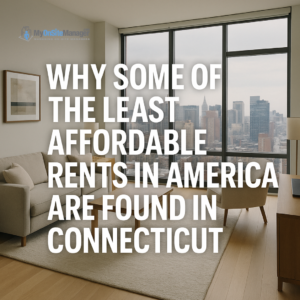Connecticut is celebrated for its charming shoreline towns, rich cultural heritage, and proximity to major metropolitan hubs like New York City and Boston. But for many residents, living in the Constitution State comes at a steep price especially when it comes to renting.
A new analysis reveals that Connecticut is home to some of the least affordable rental markets in the entire United States. From New Haven to Bridgeport, renters are dedicating an outsized share of their income to keep a roof over their heads often well beyond the financial threshold that experts consider sustainable.
The Numbers Paint a Stark Picture
According to the recent study highlighted by NBC Connecticut, both New Haven and Bridgeport rank among the top U.S. cities with the highest rent-to-income ratios.
-
New Haven residents spend approximately 32.18% of their income on rent.
-
Bridgeport residents spend about 29.8% of their income on rent.
Housing experts generally warn that once rent surpasses 30% of a household’s gross income, individuals become “cost-burdened,” meaning they may have to compromise on other essentials such as food, healthcare, transportation, and savings.
What’s Driving Connecticut’s Rent Crisis?
The factors behind Connecticut’s rent affordability challenges are layered and interconnected:
-
Low Housing Supply
The state has faced a long-term shortage of rental units, particularly in the affordable housing category. Development hasn’t kept pace with population demand, especially in job-rich areas. -
High Demand in Key Cities
Cities like New Haven and Bridgeport attract residents for their access to employment opportunities, transit connections, and universities. This demand keeps pressure on the rental market. -
Rising Property Costs
As property values rise, landlords pass these costs on to tenants in the form of higher rents. -
Stagnant Wages
While housing costs have climbed sharply over the last decade, wage growth for many workers in Connecticut has not kept pace, widening the affordability gap.
A Statewide Pattern
The issue isn’t isolated to New Haven and Bridgeport. Across Connecticut, renters are feeling the squeeze:
-
Tight Vacancy Rates: With fewer available units, renters face stiff competition, which pushes prices higher.
-
Slow Housing Development: Zoning restrictions, high construction costs, and limited land availability hinder new projects.
-
Unequal Impact: Lower-income households are disproportionately burdened, often paying a far higher share of income toward rent than higher-income earners.
The Human Impact
For those living paycheck to paycheck, the high cost of rent can mean making tough choices every month. Skipping medical appointments, delaying car repairs, or cutting back on groceries become common survival strategies.
And for some, the pressure is even greater: a sudden rent increase or loss of income can mean the difference between housing stability and homelessness. This reality is reflected in statewide discussions about affordable housing and homelessness prevention.
Possible Paths Forward
While the challenge is significant, housing experts and policymakers have outlined potential steps to address the affordability gap:
-
Expand Affordable Housing Development: Incentives for builders to create low- and moderate-income units.
-
Reform Zoning Laws: Streamlining approvals for multifamily housing could speed up construction.
-
Increase Rental Assistance Programs: Expanding subsidies for those most at risk of housing instability.
-
Encourage Mixed-Income Communities: Balancing market-rate and affordable housing to create more diverse neighborhoods.
Why It Matters Beyond Connecticut
Connecticut’s rent crisis mirrors a broader national trend where housing affordability is shrinking in many urban and suburban markets. The combination of stagnant wages, limited housing supply, and rising rents is not unique to the state but Connecticut’s high income-to-rent ratios put it at the forefront of the conversation.
If left unaddressed, these affordability challenges could impact economic growth, workforce retention, and overall quality of life in the state. Addressing them now could not only improve living conditions for current residents but also ensure the state remains attractive to future generations.
Source: Some of the least affordable rents in the country are found in Connecticut – NBC Connecticut

